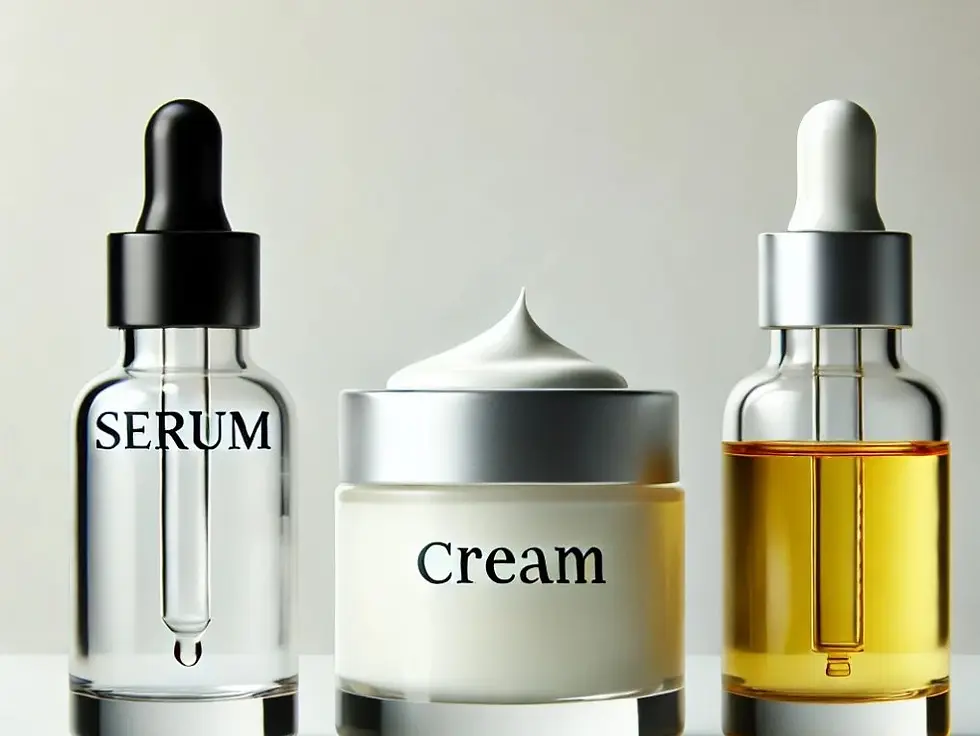Is it possible to prevent or slow down skin sagging during menopause ?
- Angéline Poulouin
- Jan 15
- 3 min read
Updated: May 24
Menopause is a significant biological transition that leads to substantial hormonal changes, particularly a marked decrease in estrogen. These hormones play a crucial role in maintaining skin elasticity and firmness. Their decline can result in sagging skin, loss of density, and increased wrinkles. However, it is possible to prevent or slow down this phenomenon through a combination of proper skincare, medical treatments, and lifestyle changes. Here is a scientific and detailed analysis of the causes, mechanisms, and solutions to combat skin sagging during menopause.
1. Why does menopause lead to skin sagging?
Impact of Estrogen:
Estrogens stimulate the production of collagen and elastin, two essential proteins that maintain skin firmness and elasticity. After menopause, estrogen levels drop significantly, leading to decreased synthesis of these proteins.
The reduction in estrogen also lowers hyaluronic acid production, a key molecule for skin hydration and volume.
Loss of Collagen:
Approximately 30% of skin collagen is lost within the first five years after menopause, with an annual decline of 2% thereafter. This loss weakens the skin’s structural support.
Thinning of the Skin:
The skin becomes thinner due to slower cell renewal and a decrease in fibroblasts, the cells responsible for producing collagen and elastin.
Effects of Intrinsic Aging:
In addition to hormonal changes, intrinsic aging, related to age and genetics, amplifies these effects by slowing down repair and renewal processes.
2. Can skin sagging be prevented or slowed down?
Yes, several strategies can be adopted to prevent or slow skin sagging. These solutions combine topical care, medical treatments, and lifestyle adjustments.
A. Tailored Skincare
Hydration and Protection:
Use creams rich in hyaluronic acid to hydrate and restore skin volume.
Apply daily sunscreen (SPF 30 or higher) to prevent UV damage, which accelerates collagen breakdown.
Collagen Stimulation:
Products containing retinol or retinoids boost collagen production and improve skin texture.
Peptides, often included in anti-aging products, strengthen existing collagen fibers.
Antioxidants:
Antioxidants such as vitamin C and vitamin E neutralize free radicals that cause premature aging and promote collagen synthesis.
B. Medical and Aesthetic Interventions
Hormone Replacement Therapy (HRT):
HRT, under medical supervision, can help offset estrogen decline. It improves skin thickness and density, although its use should be carefully evaluated due to potential contraindications.
In-Office Treatments:
Radiofrequency and High-Intensity Focused Ultrasound (HIFU): Non-invasive techniques that stimulate collagen and tighten the skin.
Microneedling: This treatment creates micro-injuries in the skin to stimulate cell regeneration and collagen production.
Filler Injections (Hyaluronic Acid): Restore volume to sagging areas, particularly in the cheeks and chin.
Fractional Lasers:
These lasers target the skin’s deeper layers to stimulate collagen production and improve firmness.
C. Healthy Lifestyle
Diet:
Consume antioxidant-rich foods (colorful fruits and vegetables) to protect the skin from free radicals.
Include protein sources (hydrolyzed collagen, fish, eggs) to support collagen synthesis.
Essential fatty acids (omega-3) found in fish and nuts strengthen the skin barrier.
Hydration:
Drink at least 1.5 to 2 liters of water per day to maintain skin hydration.
Physical Exercise:
Exercise stimulates blood circulation, promoting the delivery of nutrients and oxygen to the skin.
Stress Reduction:
Chronic stress can increase cortisol levels, a hormone that degrades collagen. Practices such as yoga, meditation, or breathing exercises can help minimize this effect.
It is entirely possible to prevent or slow down skin sagging during menopause through a combined approach of tailored skincare, medical treatments, and healthy lifestyle choices. Although hormonal changes are inevitable, proactive intervention can minimize their impact and help maintain skin firmness and radiance.


.jpg)




Comments